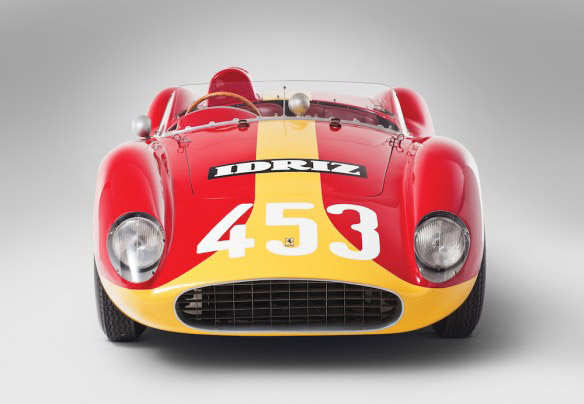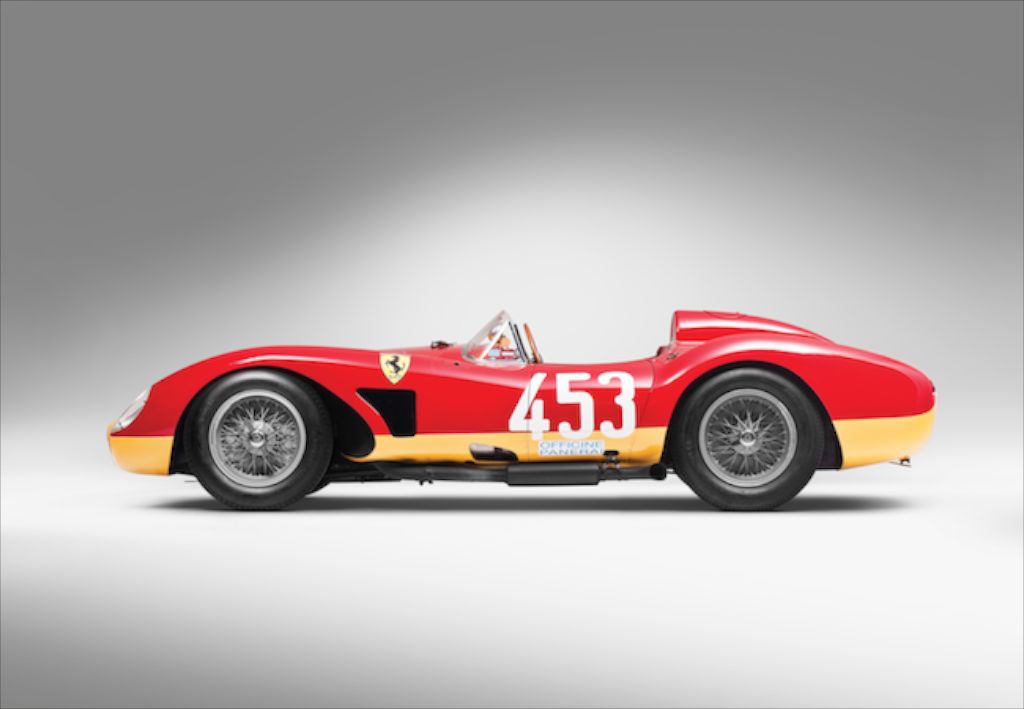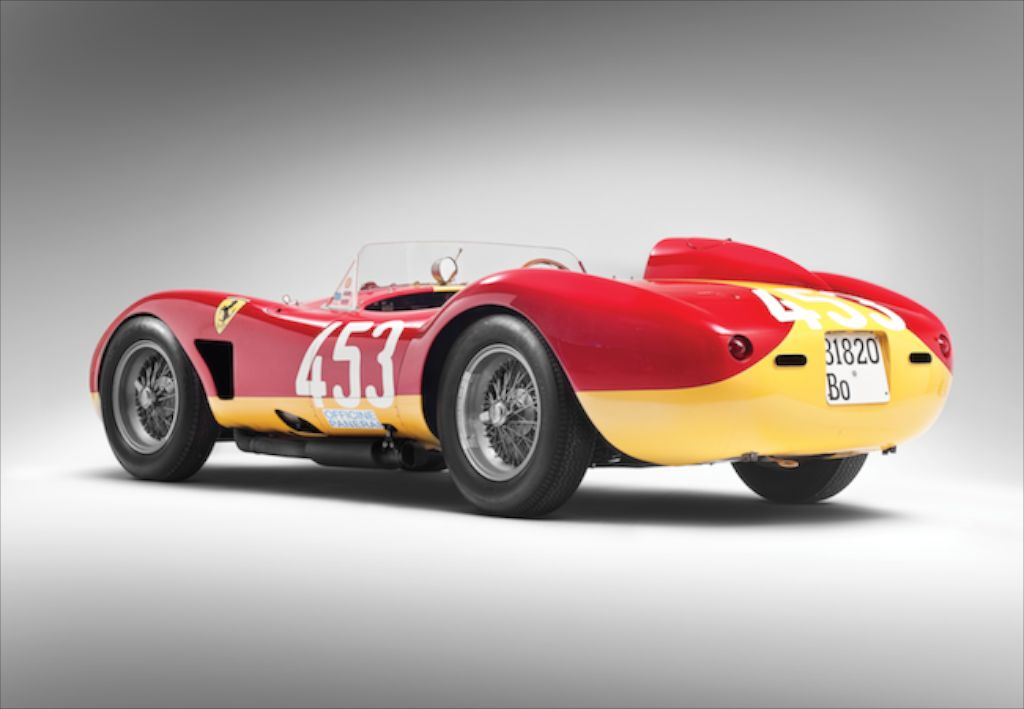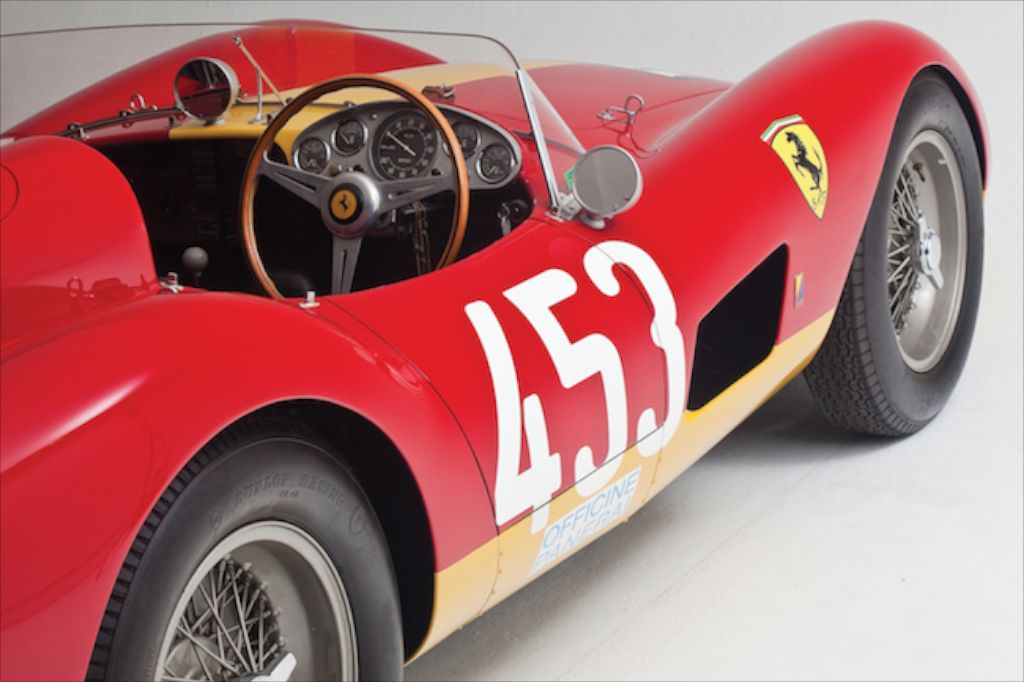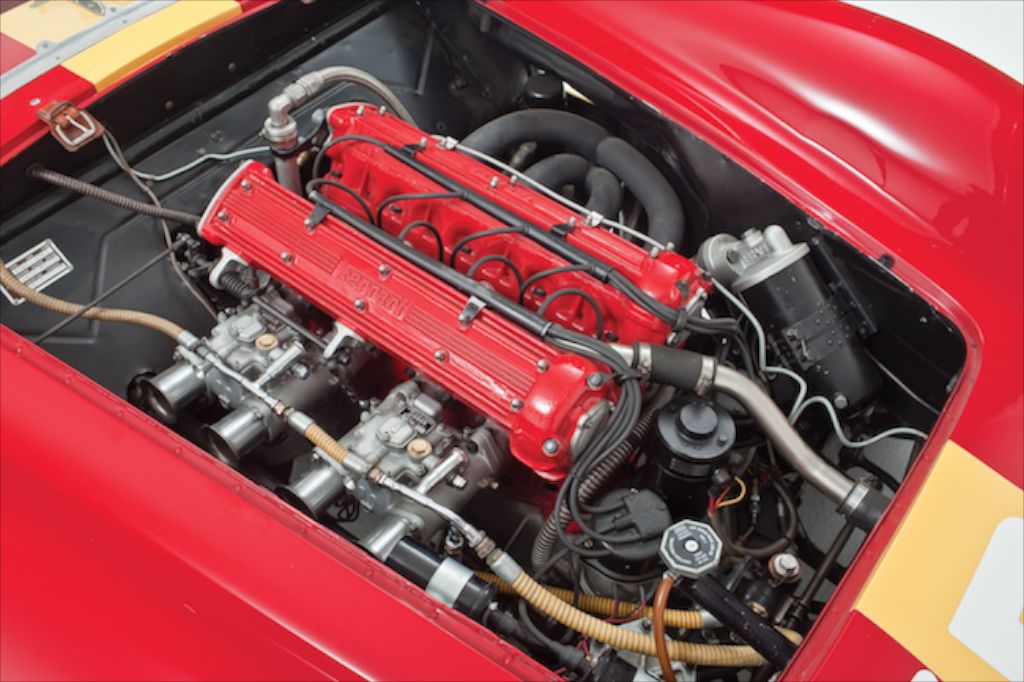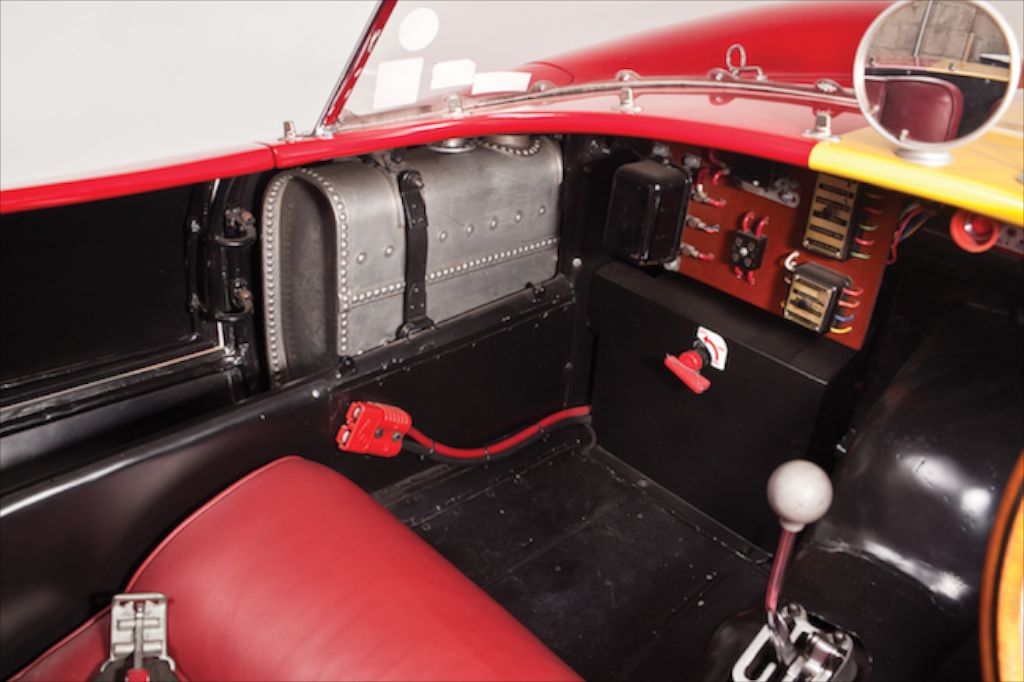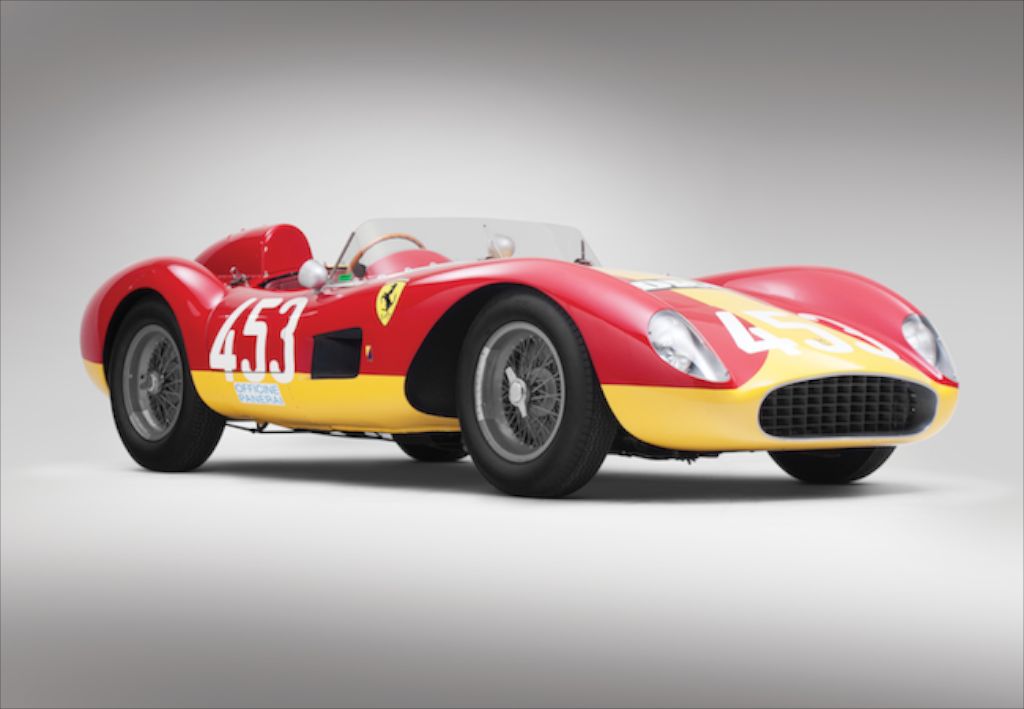Editor’s Note: Not only is this superb 1957 Ferrari 500 TRC Spider by Scaglietti presented with epic professional studio photography, the article is in both English and Italian. Thank you, RM Auctions for permitting Monterey Car Week to publish this Italian masterpiece for our readers. The Testa Rossa was auctioned off in 2010 at RM Auctions Villa d’Este sale.
Photo Credit: Hugh Hamilton ©2010 Courtesy of RM Auctions
Lot 132
1957 Ferrari 500 TRC Spider by Scaglietti
Sold for €2.800.000
Chassis no. 0670 MDTR
190 bhp, 1,985 cc inline DOHC four-cylinder engine, two Weber 40 DCO/A3 carburettors, four-speed manual transmission, independent front suspension, live rear axle, hydraulic four-wheel drum brakes. Wheelbase: 2,250 mm (88.6″)
– One of the most beautiful Ferrari sports racing cars ever built
– One of the finest examples in existence with known ownership and successful racing history
– Five Targa Florio entries and Winner of the Monte Pellegrino Hillclimb
– Last four-cylinder Ferrari sports racer, rarer than 250 TR and 250 GTO
In the 500 TRC, Ferrari developed what was to be one of the company’s most aesthetically beautiful, brilliantly engineered and efficient sports racing cars.
Following engineer Aurelio Lampredi’s departure from Ferrari in 1955, a new engineering team was formed for 1956, including Vittorio Jano, Alberto Massimino, Luigi Bellentani and the young Andrea Fraschetti. These highly skilled men soon came up with a new two-litre sports racing car: the 500 TR. This was the first Ferrari designated with the now legendary name “Testa Rossa.” The four-cylinder-engined type 500 TR was introduced in 1956 and was the successor to the 500 Mondial. Seventeen examples were built and became favourite sports racers for privateers the world over.
500 TRC
Half a year later the factory produced a new car, because the sports commission of the FIA issued new regulations. For the 1957 season the new Appendix C for modified sports cars took effect. The 500 TR was outlawed by the new rules, many of which concerned the bodywork. The windscreen now had to be symmetrical over the axis of the car, and width had to measure 100 cm with a height of at least 15 centimetres. A soft-top was required, and the gas tank capacity was to be 120 litres. A passenger door was mandated as well.
Engineers, mechanics and designers began a race against the clock. By the end of 1956, Ferrari announced the 500 TRC, a new model which adhered to all of the new FIA regulations.
The new model was assigned chassis Type 518 C and engine Type 131 C. Motor, gearbox and transmission were identical to the 500 TR. One of the primary differences between the TRC and the first Mondial, in addition to reduced weight, was the rear axle: a coil sprung rigid axle instead of the deDion variety. The two-litre engine reached its peak of performance in the TRC with 190 bhp.
More importantly, the chassis structure of the 500 TRC had been reinforced to increase rigidity. The front-end tubular frame members were further apart, which made it possible to mount the engine lower, thus lowering the centre of gravity of the whole car. This also allowed Pinin Farina to design an entirely new body that was lower by 10 centimetres, which was to be built by Scaglietti and is rightly regarded as one of the most beautiful and seductive Ferrari racing spiders ever built.
The Ferrari factory sold the TRC to private customers all over the world as a winning weapon in the sports car races. Several TRCs originally had two-tone paint, and not many were coloured the typical Ferrari racing red. The small group of 19 cars was produced within one year. Less than twelve months after its introduction, however, the 500 TRC was replaced by the 12-cylinder 250 Testa Rossa, which despite being more powerful was produced in greater numbers. As the last four-cylinder sports racing car, the 500 TRC truly marked the end of an era at Ferrari.
Chassis no. 0670 MDTR
The car on offer today is the 6th of these 19 total cars (17 500 TRCs and two 625 TRCs). Since it was built, it has been owned by a known succession of enthusiasts, the first two of which actively raced the car in period before the third owner and his family owned and maintained the car from 1966 to 1997 – more than three decades.
Chassis no. 0670 MDTR was sold new by the factory on 4 April, 1957 to first owner Bernardo Cammarata, a wealthy businessman and gentleman driver from Palermo, Sicily. Over the next decade, this gorgeous Ferrari was raced in Sicily up until 1966.
No fewer than five times was 0670 MDTR entered in the legendary Targa Florio, which alongside the Mille Miglia and Carrera Panamericana is certainly the most important open-road endurance racing event in history. In fact, seven years after its production, this 500 TRC still won the famous Monte Pellegrino hillclimb in Palermo, a race which the car had entered four times and performed in outstandingly every time. Some of the car’s greatest successes came with Mario Tropia of Sicily behind the wheel. Tropia, who went by the name “Caterpillar,” raced the car on loan from Cammarata and won two hillclimbs with the car in 1964 and in fact never placed lower than third overall.
Original owner Cammarata then sold the car to its second owner, the 36-year old Francesco Tagliavia, another Sicilian who continued to race it for the next three years, participating in several hillclimbs and adding to the car’s winning streak at Monte Pellegrino, where he won his class in 1965.
All told, of the 16 period races on record, 0670 MDTR finished all but two races and did not start one other. It won two hillclimbs outright and finished within the top three positions (overall and in class) a total of 11 times. All this, without ever being involved in a known accident in some of the most dangerous road races in history (its only two DNFs were due to the fact that Tagliavia was over the time limit and only completed 8 instead of 10 laps).
Italy’s pioneer Ferrari collector Giulio Dubbini, owner of the Diemme Caffé production company in Padua, realised the enormous potential of the 500 TRC and became the next owner in 1966. Dubbini campaigned 0670 MDTR over the next twenty years in historic events. The Ferrari remained in the ownership of the Dubbini family until the late 1990s – a remarkable period of over three decades. Historic racer Corrado Cupellini of Bergamo then took it over and for the next five years entered it in the Shell Ferrari Maserati Challenge race series in Europe.
The 500 TRC subsequently saw more than ten different racetracks in Belgium, Italy, England, Germany and France. In 2003 it was sold to Nick Colonna, who had Ferrari 0670 MDTR comprehensively restored and prepared for historic racing by Bert Skidmore’s The Intrepid Motorcar Company, Inc. of Sparks, Nevada at an approximate cost of over $470,000. It has also been shown on two occasions at the Palm Beach Cavallino Classic. The car’s file includes FIA papers, Factory Assembly Sheets (Foglio di Montaggio), a letter written by the Ferrari factory in 1966, an original “Certificato di Proprietà” from the ACI (Automobile Club Italia), various period photos and restoration documentation.
The 500 TRC, with its clean and elegant lines, is regarded as one of the most beautiful sports racing Ferraris ever built. Chassis 0670 MDTR is a matching-numbers car and totally authentic. Its entire history is known and has been very carefully researched and documented by marque experts. Moreover, it is eligible for almost every historic event in the world, be it an open road, closed racecourse or manicured show field.
Some Ferraris may have achieved greater notoriety, but to the connoisseurs, none of the front-engined cars are more important and prestigious than the highly sophisticated four-cylinder 500 TRCs. Perfect aesthetics coupled with tremendous driving pleasure.




